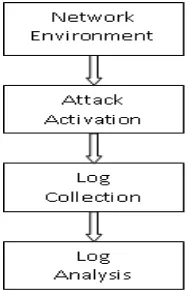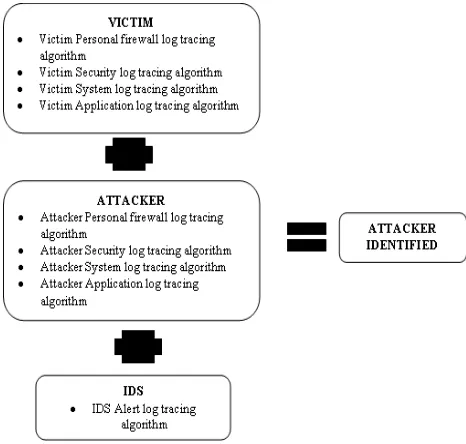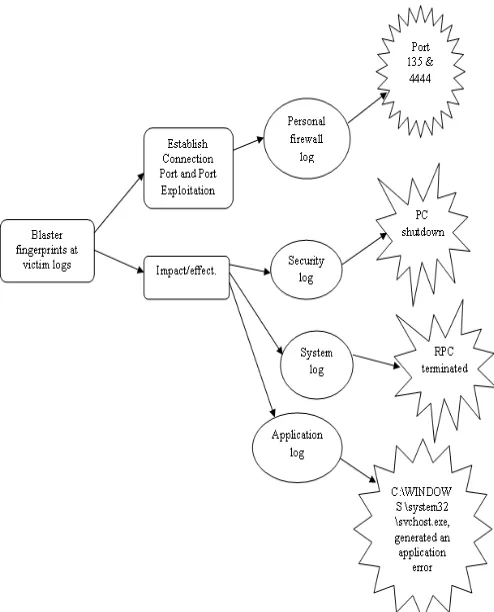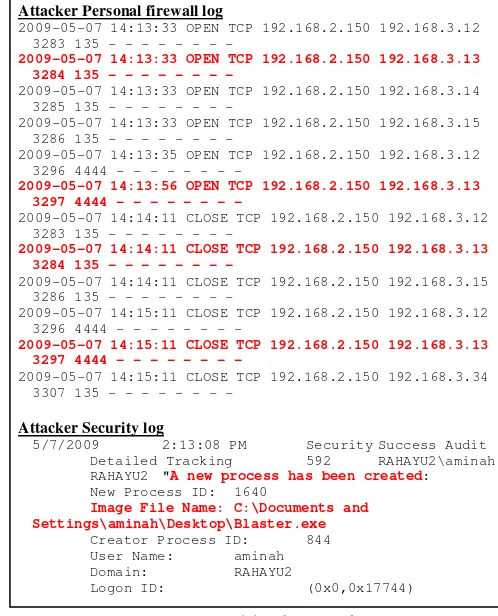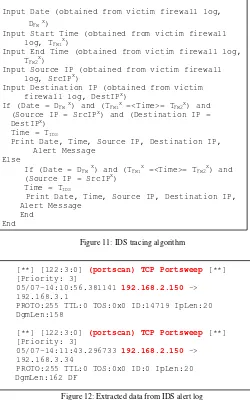Vol. 4, No. 1, 2009
Tracing Technique for Blaster Attack
Siti Rahayu S., Robiah Y., Shahrin S., Faizal M. A., Mohd Zaki M, Irda R.Faculty of Information Technology and Communication Univeristi Teknikal Malaysia Melaka,
Durian Tunggal, Melaka, Malaysia
sitirahayu@utem.edu.my, robiah@utem.edu.my, shahrinsahib@utem.edu.my, faizalabdollah@utem.edu.my,zaki.masud@utem.edu.my, irda@utem.edu.my
Abstract - Blaster worm of 2003 is still persistent, the infection appears to have successfully transitioned to new hosts as the original systems are cleaned or shut off, suggesting that the Blaster worm, and other similar worms, will remain significant Internet threats for many years after their initial release. This paper is to propose technique on tracing the Blaster attack from various logs in different OSI layers based on fingerprint of Blaster attack on victim logs, attacker logs and IDS alert log. The researchers intended to do a preliminary investigation upon this particular attack so that it can be used for further research in alert correlation and computer forensic investigation.
Keyword; Tracing technique, Blaster attack, fingerprint, log
I. INTRODUCTION
The Blaster worm of 2003 infected at least 100,000 Microsoft Windows systems and cost millions in damage. In spite of cleanup efforts, an antiworm, and a removal tool from Microsoft, the worm persists [1]. According to [2], research on Blaster attack is significant due to the multitude of malware such as Blaster worm has itself evolved into a complex environment and has potential for reinfection by either itself or another worm, to occur using the same exploit.
Recent tools targeted at eradicating it appear to have had little effect on the global population. In the persistent population analysis, the infection appears to have successfully transitioned to new hosts as the original systems are cleaned or shut off, suggesting that the Blaster worm, and other similar worms, will remain significant Internet threats for many years after their initial release and its suggested that the Blaster worm is not going away anytime soon. Therefore, the objective of this paper is to propose technique on tracing the Blaster attack from various logs in different OSI layers. The researchers intended to do a preliminary investigation upon this particular attack so that it can be used for further research in alert correlation and computer forensic investigation.
II. RELATED WORK
W32.Blaster.Worm is a worm that exploits the DCOM RPC vulnerability (described in Microsoft Security Bulletin MS03-026) using TCP port 135. If a connection attempt to TCP port 135 is successful, the worm sends an RPC bind command and an RPC request command containing the buffer overflow and exploit code. The exploit opens a backdoor on TCP port 4444, which waits for further commands. The infecting system then issues a command to the newly infected system to transfer the worm binary using Trivial File Transfer Protocol (TFTP) on UDP port 69 from the infecting system and execute it.
The worm targets only Windows 2000 and Windows XP machines. While Windows NT and Windows 2003 Server machines are vulnerable to the aforementioned exploit (if not properly patched), the worm is not coded to replicate to those systems. This worm attempts to download the msblast.exe file to the %WinDir%\system32 directory and then execute it.
The Blaster worm’s impact was not limited to a short period in August 2003. According to [3], a published survey of 19 research universities showed that each spent an average of US$299,579 during a five-week period to recover from the Blaster worm and its variants. The cost of this cleanup effort has helped solidify a growing view of worms not as acts of Internet vandalism but as serious crimes. Although the original Blaster.A author was never caught, authors of several other variants have been apprehended.
specification-Vol. 4, No. 1, 2009 based detection according to [6] will rely on program
specifications that describe the intended behaviour of security-critical programs. The research trend for detecting attack has move towards combination or hybrid of either signature-based with anomaly-based done by [7], [8] and [5] or specification-based with anomaly-based done by [9].
For the purpose of this preliminary experiment, the researchers have selected only signature-based detection technique and in future, intend to combine it with anomaly-based detection technique for further improvement of tracing attack.
System log files contain valuable evidence pertaining to computer attacks. However, the log files are often massive, and much of the information they contain is not relevant to the network administrator. Furthermore, the files almost always have a flat structure, which limits the ability to query them. Thus, it is extremely difficult and time consuming to extract and analyse the trace of attacks from log files [10]. This paper will select the most valuable attributes from a log file that is relevance to the attack being traced. Our research is preliminary experiment of tracing the Blaster.B attack in diverse log resources to provide more complete coverage of the attack space [11].
According to [12], the network attack analysis process involves three main procedures: initial response, media imaging duplication, and imaged media analysis. Our proposed approach focuses on the procedure of media imaging duplication and imaged media analysis. This paper describes how procedure can be applied to the numerous logs, which can derive the top facts in each of the diverse connections and locate malicious events spread across the network.
III. EXPERIMENT APPROACH
Our proposed approach in this preliminary experiment used four methods: Network Environment Setup, Attack Activation, Log Collection and Log Analysis and its depicted in Figure 1. The details of the method are discussed in the following sub-section.
Figure 1: Method use in the preliminary experiment
A. Network Environment Setup
The network setup for this experiment will refer to the network simulation setup [13] done by the MIT Lincoln Lab and it has been slightly modified using only Centos and
Windows XP compared to MIT Lincoln Lab which using
Linux, Windows NT, SunOS, Solaris, MacOS and Win98 to suit our experiment’s environment. The network design is as shown below in Figure 2.
Figure 2: Preliminary Network Design for Blaster Attack Simulation
This network design consists of two switches configured to Vlan 3 (192.168.3.0) and Vlan 2 (192.168.2.0), one router, two servers for Intrusion Detection System (IDS) and Network Time Protocol (NTP) run on Centos 4.0, two victims run on Windows XP on each Vlan and one attacker run on Vlan 2. The log files that expected to be analysed are four types of log files (personal firewall log, security log, system log and application log)
that shall be generated by host level device and one log files by network level device (alert log by IDS). Ethereal 0.10.7 [6] were installed in each host to verify the traffic between particular host and other device and tcpdump script is activated in IDS to capture the traffic for the whole traffic within Vlan 2 and Vlan 3.
B. Attack Activation
Vol. 4, No. 1, 2009 machine is successfully infected by the Blaster, the
experiment is terminated.
C. Log Collection
Log is collected at two different OSI layers which are application layer and network layer. Each victim and attacker machine will generated personal firewall log, security log, application log, system log and ethereal log. The IDS machine will generate alert log and tcpdump log. Ethereal and tcpdump files are used to verify the simulation attack and compare it with the others log files. For the purpose of this paper, both verification logs are not discussed due to limited page. The summary of the various log files generated is as shown in Table I.
TABLE I. Various log files generated from two different OSI layers
C. Log Analysis
In this network attack analysis process the researchers has implement the media imaging duplication using IDS and imaged media analysis by analysing logs generated in Table 1. The objective of the log analysis is to identify the Blaster attack by observing the specific characteristics of the Blaster attack which exploits the DCOM RPC vulnerability using TCP port 135. This worm attempts to download the msblast.exe file to the %WinDir%\system32 directory and then execute it. The exploit opens a backdoor on TCP port 4444, which waits for further commands. In this analysis, the researchers have selected the valuable attributes that is significance to the attack being traced as shown in Table II.
TABLE II. Selected Log Attribute
Log filenames Selected Log Attribute Variable pfirewall.log • Source IP address
• Destination IP Address
• Destination port
• Source port
• Action
• Date
• Time
• SrcIP
• DstIP
• Dstport
• Srcport
• Act
• D
• T
security.evt • Date
• Time
• Category
• D
• T
• Cat application.evt
system.evt
alert.log • Date
• Time
• Source IP address
• Destination IP Address
• Category
• D
• T
• SrcIP
• DstIP
• Cat
IV. PROPOSED TRACING TECHNIQUE
In order to identify the attacker, the researchers have proposed a tracing technique as depicted in Figure 3, consists of three elements: victim, attacker and IDS. The algorithm used in each element will be elaborated in the next sub-section.
Figure 3: Proposed Tracing Technique
A. Tracing Algorithm for Victim logs
Vol. 4, No. 1, 2009 Blaster fingerprint is derived from several studies done by
[14], [15], [16].
Figure 4: Fingerprint of Blaster attack in each selected victim logs
In this analysis, the researchers have specified 192.168.3.13 as one of the victim and 192.168.2.150 as attacker (refer to Figure 2). The tracing tasks are initially started at the victim personal firewall log followed by
security log, system log and application log. The data can be further analysed by referring to Blaster fingerprint for attacker logs by examine the attacker personal firewall and
security log. Figure 6, 9 and 12 is the relevant information that has been extracted from selected logs.
Figure 5 shows the tracing algorithm for each selected victim logs based on Blaster attack fingerprint as in Figure 4.
The aim of these tracing tasks is to examine the trace left by the Blaster in the selected log. The trace is based on the Blaster attack fingerprint which primarily done at
personal firewall log. In these tracing tasks, the researchers have manipulated the attributes selected in Table II. The searching start with the victim IP address is 192.168.3.13, and the action is OPEN-BOUNDED which show the attacker is trying to open the connection. The protocol used is TCP and the destination port is 135 which show that Blaster attack attempt to establish connection.
Where,
x = Victim Host y = Attacker Host
Victim Personal firewall log tracing algorithm
Input Action, Protocol, Destination Port
If (Action = Open-Inbound) and (Protocol = TCP) and (Destination Port = 135)
Date = DFW Destination IP = DestIPx
Source Port = SrcPortax
Print Source IP, Date, Time, Source Port, Destination IP, Action, Protocol, Destination Port
Print Source IP, Date, Time, Source Port, Destination IP, Action, Protocol, Destination Port
End End
Victim Security log tracing algorithm
Input Date (DFW x)
Input Time (TFW2 x (AuditCategory = ‘\system32\svchost.exe, generated an application error’)
Time = TAppl x
Date = DAppl x
Print Time, Date, AuditCategory End
Victim System log tracing algorithm
Input Date (DAppl x
) Input Time (TAppl
x (AuditCategory = ‘The Remote Procedure Call (RPC) service terminated unexpectedly’) Time = TimeSys
x
Date = DateSys x
Print Time, Date, AuditCategory End
Victim Application log tracing algorithm
Input Date (DSys x
) Input Time (TSys
x
) Input AuditCategory
If (Date = DSys x) and (Time >= TSys x) and
(AuditCategory = ‘Windows is shutting down’) Time = TimeSec x
Date = DateSec x
Print Time, Date, AuditCategory End
Vol. 4, No. 1, 2009
Victim Personal firewall log
2009-05-07 14:13:34 OPEN-INBOUND TCP 192.168.2.150 192.168.3.13 3284 135 - - -
2009-05-07 14:14:01 DROP TCP 192.168.2.150
192.168.3.13 3297 4444 48 S 862402054 0 64240 - - -
Victim Security log
5/7/2009 2:20:03 PM Security
Success Audit System Event 513 NT
AUTHORITY\SYSTEM AYU Windows is shutting
down. All logon sessions will be terminated by
this shutdown.
Victim System log
5/7/2009 2:19:00 PM Service Control
Manager Error None 7031 N/A AYU
The Remote Procedure Call (RPC) service terminated unexpectedly. It has done this 1 time(s). The following corrective action will be taken in 60000 milliseconds: Reboot the machine.
5/7/2009 2:19:00 PM USER32 Information
None 1074 NT AUTHORITY\SYSTEM AYU
The process winlogon.exe has initiated the restart of AYU for the following reason: No title for this reason could be found
Minor Reason: 0xff Shutdown Type: reboot
Comment: Windows must now restart because the Remote Procedure Call (RPC) service terminated unexpectedly
Victim Application log
5/7/2009 2:20:01 PM EventSystem Error
(50) 4609 N/A AYU The COM+
Event System detected a bad return code during its internal processing. HRESULT was 800706BA from line 44 of
d:\nt\com\com1x\src\events\tier1\eventsystemobj .cpp. Please contact Microsoft Product Support Services to report this error.
5/7/2009 2:19:00 PM DrWatson
Information None 4097 N/A AYU
The application,
C:\WINDOWS\system32\svchost.exe, generated an application error The error occurred on 05/07/2009 @ 14:19:00.441 The exception generated was c0000005 at address 0018759F (<nosymbols>)
5/7/2009 2:14:00 PM Application Error
Error (100) 1000 N/A AYU
Faulting application svchost.exe, version 5.1.2600.0, faulting module unknown, version 0.0.0.0, fault address 0x00000000.
5/7/2009 2:20:03 PM EventLog
Information None 6006 N/A AYU The Event log service was stopped.
Figure 6: Extracted data from Victim logs
From these trace, the source IP address (SrcIPx) and source port of potential attacker is known where source IP address is 192.168.2.150, source port (SrcPortax) is 3824 and the date and time is 2009-05-07 14:13:34 also known to shows when the attack is happen.
Subsequently, to trace whether the attack was exploited, the log is further search on the same date and time within the range of the Blaster attack attempt to establish connection. The destination IP address (DestIPx) is victim IP address, the source IP address (SrcIPx) is the potential attacker IP address, the action is DROP, protocol used is TCP and destination port is 4444. From this trace, the potential attacker source port is known and it indicates that the Blaster is exploited using port 4444. This attack can be further verified by examining the personal firewall log at the machine of the potential attacker.
To support the information obtained in personal firewall log, further investigation done in the security log, system log and application log. The effect of the exploitation can be traced by looking at the message embedded in the application log, system log and security log
which shows message “C:\WINDOWS\system32\svchost.exe, generated an
application error”, “Windows must now restart because the Remote Procedure Call (RPC) service terminated unexpectedly” and “Windows is shutting down. All logon sessions will be terminated by this shutdown” respectively. All of these messages shown the effect of Blaster attack, which it exploits the RPC services. The highlighted data in Figure 6 is extracted by using the tracing algorithm in Figure 5 accordingly.
B. Tracing Algorithm for Attacker logs
The tracing algorithm for tracing the attacker logs in Figure 8 is based on Blaster attack fingerprint in Figure 7. The same tracing step in victim logs is used in investigating the attacker logs. The only difference is the action is OPEN and extra information obtained from previous tracing tasks: source port (SrcPortax), date (DFWx) and time (TFW1x) is used to verify the existence of communications between attacker and victim machine on port 135.
Vol. 4, No. 1, 2009 Then, to verify that there is an exploitation done by
attacker to victim machine, the main attributes used in the
personal firewall log are destination IP address, action is OPEN, protocol is TCP, destination port is 4444, source port (SrcPortex), date (DFWx) and time (TFW2y).
To validate the information obtained in the attacker personal firewall log, further analysis done in the security log, system log and application log. The process created is found in the security log with the message “A new process has been created and the Image File Name: C:\Documents and Settings\aminah\Desktop\Blaster.exe”.
Where,
x = Victim Host y = Attacker Host
Attacker Personal firewall log tracing algorithm
Input Action, Protocol, Destination Port Input Date (obtained from tracing victim log,
DFW x)
Input Time (obtained from firewall victim log, TFW1 x)
Input Source IP (obtained from firewall victim log, SrcIPx)
Input Destination IP (obtained from firewall victim log, DestIPx)
Input Source Port to attempt attack (obtained from firewall victim log, SrcPortax) Input Source Port to exploit attack (obtained
from firewall victim log, SrcPortex) If (Action = Open) and (Protocol = TCP) and
(Destination Port = 135) and (Date = DFWx) and(Time <= TFW1 x) and (Source IP = SrcIPx) and (Destination IP = DestIPx) and (Source Port = SrcPortax)
Time = TFW1y Date = DFWy
Print Source IP, Destination IP, Date, Time, Source Port, Destination Port, Protocol, Action
If (Action = Open) and (Protocol = TCP) and (Destination Port = 4444) and (Date = DFWy) and (Time >= TFW1y) and (Source IP = SrcIPx) and (Destination IP = DestIPx) and (Source Port = SrcPortex)
Time = TFW2 y
Print Source IP, Date, Time, Source Port,
Destination IP, Action, Protocol, Destination Port
End End
Attacker Security log tracing algorithm
Input Date (DFWy) Input Time (TFW2y) Input AuditCategory
If (Date = DFWy) and (Time >= TFW2y) and
(AuditCategory = ‘Windows is shutting down’) Time = TimeSec y
Date = DateSec y
Print Time, Date, AuditCategory End
Figure 8: Tracing algorithm for Attacker logs
The highlighted data in Figure 9 is extracted by using the tracing algorithm in Figure 8 accordingly.
From the tracing, there is an evidence shows that the attack is launched by this attacker machine (192.168.2.150) at 2009-05-07 14:13:33 which is concurrent with the extracted data in Figure 6. Hence, the attacker can be identified using this tracing algorithm.
Attacker Personal firewall log
2009-05-07 14:13:33 OPEN TCP 192.168.2.150 192.168.3.12 3283 135 - - -
2009-05-07 14:13:33 OPEN TCP 192.168.2.150 192.168.3.13 3284 135 - - -
2009-05-07 14:13:33 OPEN TCP 192.168.2.150 192.168.3.14 3285 135 - - -
2009-05-07 14:13:33 OPEN TCP 192.168.2.150 192.168.3.15 3286 135 - - -
2009-05-07 14:13:35 OPEN TCP 192.168.2.150 192.168.3.12 3296 4444 - - -
2009-05-07 14:13:56 OPEN TCP 192.168.2.150 192.168.3.13 3297 4444 - - -
2009-05-07 14:14:11 CLOSE TCP 192.168.2.150 192.168.3.12 3283 135 - - -
2009-05-07 14:14:11 CLOSE TCP 192.168.2.150 192.168.3.13 3284 135 - - -
2009-05-07 14:14:11 CLOSE TCP 192.168.2.150 192.168.3.15 3286 135 - - -
2009-05-07 14:15:11 CLOSE TCP 192.168.2.150 192.168.3.12 3296 4444 - - -
2009-05-07 14:15:11 CLOSE TCP 192.168.2.150 192.168.3.13 3297 4444 - - -
2009-05-07 14:15:11 CLOSE TCP 192.168.2.150 192.168.3.34 3307 135 - - -
Attacker Security log
5/7/2009 2:13:08 PM Security Success Audit Detailed Tracking 592 RAHAYU2\aminah RAHAYU2 "A new process has been created:
Figure 9: Extracted data from Attacker logs
C. Tracing Algorithm for IDS logs
The Blaster attack fingerprint in Figure 10 is the base for tracing algorithm in IDS alert logs as depicted in Figure 11.
Figure 10: Fingerprint of Blaster attack in IDS log Blaster fingerprint
at IDS Alert logs
Vol. 4, No. 1, 2009 To confirm that there is an exploitation done by attacker,
extra information can be obtained from IDS alert log. The main attributes used in the IDS alert log are date, time, Source IP Address and destination IP address. If the destination IP address does not exist, the alert has generated false positive alert. However, existence of source IP address is good enough to verify that this source IP address had launched an attack as reported as portsweep activity in IDS alert log shown in Figure 12.
Input Date (obtained from victim firewall log,
DFW x)
Input Start Time (obtained from victim firewall log, TFW1
x
)
Input End Time (obtained from victim firewall log, TFW2
x
)
Input Source IP (obtained from victim firewall log, SrcIPx
)
Input Destination IP (obtained from victim firewall log, DestIPx
) If (Date = DFW
x
) and (TFW1 x
=<Time>= TFW2 x
Print Date, Time, Source IP, Destination IP, Alert Message
Print Date, Time, Source IP, Destination IP, Alert Message
End End
Figure 11: IDS tracing algorithm
[**] [122:3:0] (portscan) TCP Portsweep [**] [Priority: 3]
05/07-14:10:56.381141 192.168.2.150 -> 192.168.3.1
PROTO:255 TTL:0 TOS:0x0 ID:14719 IpLen:20 DgmLen:158
[**] [122:3:0] (portscan) TCP Portsweep [**] [Priority: 3]
05/07-14:11:43.296733 192.168.2.150 -> 192.168.3.34
PROTO:255 TTL:0 TOS:0x0 ID:0 IpLen:20 DgmLen:162 DF
Figure 12: Extracted data from IDS alert log
The extracted data depicted from Figure 12, verified that the source IP address (192.168.2.150) is the attacker due to the port scanning alarm generated by the IDS. Thus, all the three tracing algorithm have the capability to identify the attacker.
V. CONCLUSION AND FUTURE WORKS
In this study, the researchers have reviewed and analysed the Blaster attack from various logs in different
OSI layers and researchers’ approach focuses on the procedure of media imaging duplication and imaged media analysis. Researchers have selected the most valuable attributes from the log files that are relevance to the attack being traced. From the analysis researcher has propose a technique on tracing the Blaster attack using specific tracing algorithm as in Figure 3 for each log which is based on fingerprint of Blaster attack on victim logs, attackers logs and IDS alert log. This tracing technique is primarily used signature-based technique and later on the researchers intend to merge it with anomaly-based technique to improve the tracing capability. All of these logs are interconnected from one log to another log to provide more complete coverage of the attack space information. Further improvement should be done on generalising the process of detecting the worm attack that will produce attack and trace pattern for alert correlation and computer forensic investigation research.
VI. REFERENCES
[1]. Bailey, M., Cooke, E., Jahanian, F., Watson, D., & Nazario, J. (2005). The Blaster Worm: Then and Now. IEEE Computer Society
[2]. Crandall, J. R., Ensafi, R., Forrest, S., Ladau, J., & Shebaro, B. (2008). The Ecology of Malware. ACM . [3]. Foster, A. L. (2004). Colleges Brace for the Next
Worm. The Chronicle of Higher Education, 50 (28), A29.
[4]. Okazaki, Y., Sato, I., & Goto, S. (2002). A New Intrusion Detection Method based on Process Profiling. Paper presented at the Symposium on Applications and the Internet (SAINT '02) IEEE.
[5]. Sekar, R., Gupta, A., Frullo, J., Shanbhag, T., Tiware, A., & Yang, H. (2002). Specification-based Anomaly Detection: A New Approach for DetectingNetwork Intrusions. Paper presented at the ACM Computer and Communication Security Conference.
[6]. Ko, C., Ruschitzka, M., & Levitt, K. (1997). Execution monitoring of security critical programs in distributed systems: A Specification-based Approach. Paper presented at the IEEE Symposium on Security and Privacy.
[7]. Bashah, N., Shanmugam, I. B., & Ahmed, A. M. (2005). Hybrid Intelligent Intrusion Detection System. Paper presented at the World Academy of Science, Engineering and Technology, June 2005.
[8]. Garcia-Teodoro, P., E.Diaz-Verdejo, J., Marcia-Fernandez, G., & Sanchez-Casad, L. (2007). Network-based Hybrid Intrusion Detection Honeysystems as Active Reaction Schemes. IJCSNS International Journal of Computer Science and Network Security, 7(10, October 2007).
Vol. 4, No. 1, 2009 presented at the 18th Annual Computer Security
Applications Conference (ACSAC '02), IEEE
[10]. Poolsapassit, N., & Ray, I. (2007). Investigating Computer Attacks using Attack Trees. Advances in Digital Forensics III, 242, 331-343.
[11]. Yusof, R., Selamat, S. R., & Sahib, S. (2008). Intrusion Alert Correlation Technique Analysis for Heterogeneous Log. IJCSNS International Journal of Computer Science and Network Security, 8(9)
[12]. Kao, D.-Y., Wang, S.-J., Huang, F. F.-Y., Bhatia, S., & Gupta, S. (2008). Dataset Analysis of Proxy Logs Detecting to Curb Propagations in Network Attacks. Paper presented at the ISI 2008 Workshops.
[13]. Lincoln Lab, M. (1999). 1999 DARPA Intrusion Detection Evaluation Plan [Electronic Version].
[14]. McAfee. (2003). Virus Profile:
W32/Lovsan.worm.a [Electronic Version]. Retrieved
23/7/09 from http://home.mcafee.com/VirusInfo/VirusProfile.aspx?k
ey=100547.
[15]. Microsoft. (2003). Virus alert about the Blaster worm and its variants [Electronic Version]. Retrieved 23/7/09 from http://support.microsoft.com/kb/826955. [16]. Symantec. (2003). W32.Blaster.Worm [Electronic
Version]. Retrieved 23/7/09 from http://www.symantec.com/security_response/writeup.js
